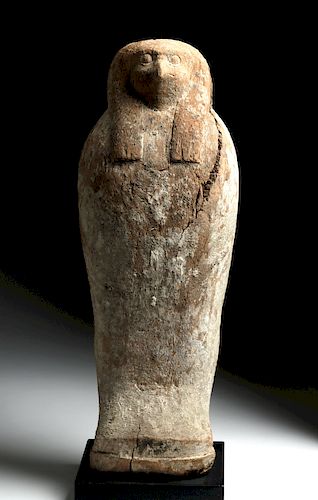Rare Egyptian Wood Sarcophagus of Falcon / Horus
Lot 16
About Seller
Artemis Fine Arts
686 S Taylor Ave, Ste 106
Louisville, CO 80027
United States
Selling antiquities, ancient and ethnographic art online since 1993, Artemis Gallery specializes in Classical Antiquities (Egyptian, Greek, Roman, Near Eastern), Asian, Pre-Columbian, African / Tribal / Oceanographic art. Our extensive inventory includes pottery, stone, metal, wood, glass and textil...Read more
Estimate:
$25,000 - $35,000
Absentee vs Live bid
Two ways to bid:
- Leave a max absentee bid and the platform will bid on your behalf up to your maximum bid during the live auction.
- Bid live during the auction and your bids will be submitted real-time to the auctioneer.
Bid Increments
| Price | Bid Increment |
|---|---|
| $0 | $25 |
| $300 | $50 |
| $1,000 | $100 |
| $2,000 | $250 |
| $5,000 | $500 |
| $10,000 | $1,000 |
| $20,000 | $2,500 |
| $50,000 | $5,000 |
| $100,000 | $10,000 |
| $200,000 | $20,000 |
About Auction
By Artemis Fine Arts
Feb 21, 2019
Set Reminder
2019-02-21 10:00:00
2019-02-21 10:00:00
America/New_York
Bidsquare
Bidsquare : Exceptional Antiquities, Asian, Ethnographic
https://www.bidsquare.com/auctions/artemis-gallery/exceptional-antiquities-asian-ethnographic-3858
An important one-day auction featuring museum-worthy examples of Egyptian, Greek, Roman, Etruscan, Near Eastern, Far East / Asian, Pre-Columbian, African / Tribal, Oceanic, Native American, Spanish Colonial, Russian, Fossils, Ancient Jewelry, Fine Art, so much more! Artemis Fine Arts info@artemisfinearts.com
An important one-day auction featuring museum-worthy examples of Egyptian, Greek, Roman, Etruscan, Near Eastern, Far East / Asian, Pre-Columbian, African / Tribal, Oceanic, Native American, Spanish Colonial, Russian, Fossils, Ancient Jewelry, Fine Art, so much more! Artemis Fine Arts info@artemisfinearts.com
- Lot Description
Egypt, Late Dynastic Period, ca. 26th to 31st Dynasty, ca. 664 to 332 BCE. An incredibly rare, hand-carved and painted wood (likely cedar) lidded mummiform sarcophagus depicting Falcon Bird Horus - the lid presenting a finely delineated avian visage comprised of large round, wide-open eyes and a protruding curved beak framed by a royal tripartite wig with a mummiform body. The orb-like eyes of Horus are apropos, as the falcon deity's right eye was interpreted as the sun or morning star, representing mighty power, and his left eye was understood as the moon or evening star, representing the ability to heal. The lower section is joined to it via wooden pegs. An incredibly rare artifact with traces of painted gesso details upon the face and body. Size: 20.5" H (52.1 cm); 22" H (55.9 cm) on included custom stand.
The ancient Egyptians believed that their pharaoh was a personification of Horus the sky god - depicted as either a falcon-headed man donning the pschent (a red and white crown) to symbolize his reign over Egypt or as the bird itself - a powerful icon of power, speed, and talent for hunting - as we see in this example. Certainly this association between Horus and the king existed from the early Dynastic period (ca. 3100 BCE); however, the Horus king cult became very popular during the Ptolemaic Period. What's more statues of Horus were created to adorn temples as an image of kingship - capturing an image of Horus on earth.
Interestingly, cedar wood was not native to Egypt. Egypt did not have verdant forests filled with tall trees, and unfortunately most of its native lumber was of relatively poor quality. Thus, they relief on importing to acquire hardwoods - ebony imported from Africa, cedar and pine from Lebanon. One fabulous obelisk inscription by Thutmose III attests to the luxury of hardwoods. It reads as follows, "They brought to me the choicest products …consisting of cedar, juniper and of meru wood … all the good sweet woods of God's Land." The rarity of cedar meant that masks like this example were reserved for those who could afford them.
Provenance: ex-Arte Primitivo, June 28, 2008, Lot 325; ex-private Pennsylvania, USA collection
All items legal to buy/sell under U.S. Statute covering cultural patrimony Code 2600, CHAPTER 14, and are guaranteed to be as described or your money back.
A Certificate of Authenticity will accompany all winning bids.
We ship worldwide and handle all shipping in-house for your convenience.
#141587Age cracks/fissures and losses to top of head and peripheries as shown. Long, stable age crack from the left side to the falcon's head to his chest. Expected weathered surface with pigment/gesso losses commensurate with age, but some still graces the sarcophagus. Held closed with original wooden dowels/pegs.Condition
- Shipping Info
-
All shipping is handled in-house for your convenience. Your invoice from Artemis Gallery will include shipping calculation instructions. If in doubt, please inquire BEFORE bidding for estimated shipping costs for individual items.
-
- Buyer's Premium



 EUR
EUR CAD
CAD AUD
AUD GBP
GBP MXN
MXN HKD
HKD CNY
CNY MYR
MYR SEK
SEK SGD
SGD CHF
CHF THB
THB

















